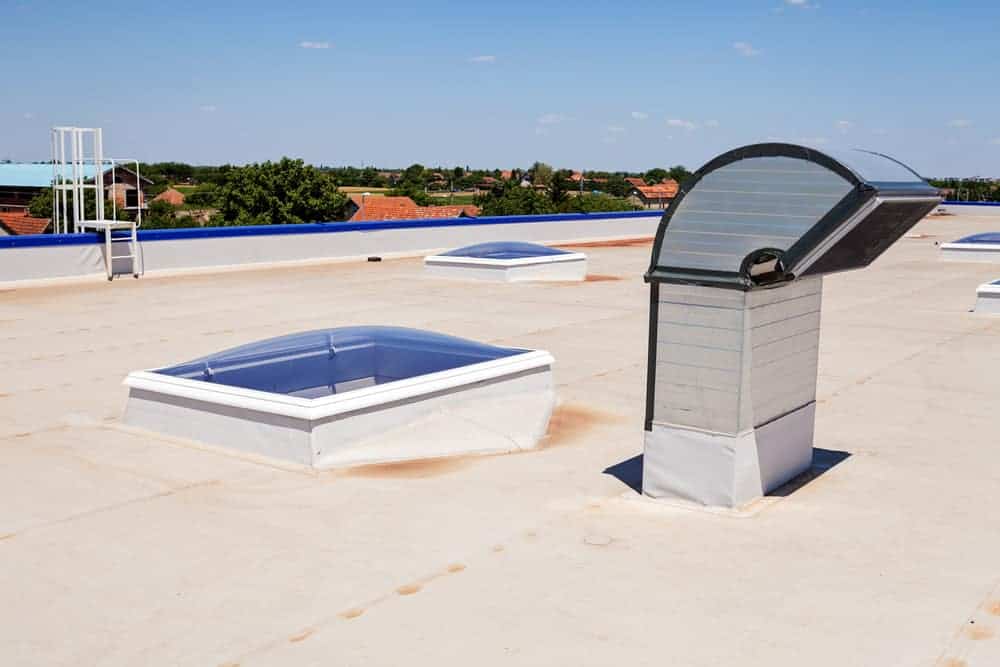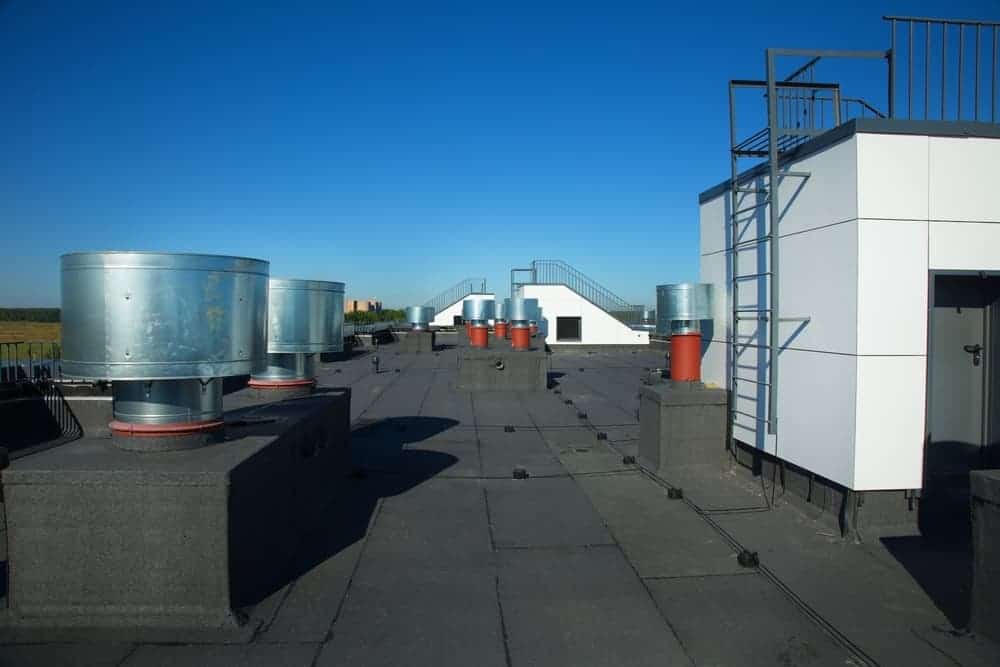Why are Flat Roofs Common on Commercial Buildings?

When a person thinks of a roof, they almost always imagine the peaked roofing of their home, but if you look around next time you’re out in the city, you’ll notice the majority of roofs are actually flat, especially on commercial buildings. Indeed flat roofing is not only just as effective as sloped roofing, but is even more cost-effective, and tends to fit into the uniform ideal that most business and industrial districts demand.
Flat, or low-slope, roofing is roofing with anywhere from three to twelve degrees of slope relative to the walls. While originally popular for desert-based civilizations and castles, flat roofing has become synonymous with the business districts and high rise downtowns of the world. Part of what spurred this choice was the development of better, more cost-effective roofing materials that could be mass produced to a high standard.
Materials
TPO – Thermoplastic Polyolefin is a durable synthetic material similar in properties to EPDM another kind of sythetic rubber roofs and gains enhanced heat resistance from its employment of a vinyl composite in its makeup. While a slightly more expensive than the EPDM option, TPO benefits from a higher level of UV protection, a structural integrity that makes it capable of supporting heavy equipment.
PVC – Polyvinyl Chloride sees extensive usage in the form of piping networks, some decking, and even some furniture. Likewise, the durable material is used by some companies to create sturdy roofing membranes. PVC roofing is in fact so sturdy that it can handle loads of more than 350 pounds per square inch, 100 pounds per inch more than the minimum required by law.
EPDM – EPDM is the lowest cost per square foot of any flat-roofing material, indeed the similar TPO can cost as much as 6-11 times as much per square foot as much as EPDM with PVC costing even more. Nonetheless, the lower cost does bring disadvantages, such as the possibilty of heavy materials and branches puncturing the roof when they fall. Even with these drawbacks in mind however, EPDM is still capable of roofing and insulating a commercial building for over 30 years.
Asphalt – Though Asphalt is a material typically used in the construction of roads and bridge, it also has a long history in the roofing industry. Many manufacturers now produce asphalt roofing materials for roofing membranes for flat-roofed buildings. These membranes are tough and rugged and are considered by roofing contractors to be among the best availablebecause with a life span of over fifty years and is excellent for insulation, asphalt roofing is far and away the most versatile and durable roofing materials out there.
Metal– Many flat-roofed warehouses employ metal as a roofing material due to its practicality, logetivity, and efficiency. Metal roofs on flat topped structures can last for over 30 years and is the go to choice for most property owners due to its ease of repair and durability though it is often one of the higher priced options for roofing materials.
Why Choose A Flat Roof?
flat roofing has nonetheless gone on to become popular for my reasons than just quality of materials:

It’s Economic and Efficient!
Flat roofs can be expensive up front, nearly 80 cents per foot if you’re using some of the higher end materials, But a person will quickly find that their roofs will last almost 30 years average with minimal maintenance. For those willing to increase their budgets and purchase some of the higher end roofing materials, this lifespan can become even longer. Additionally, many contractors will charge much less for labor on flat roofs due to the simplicity of installation.
They Have Curb Appeal-
Most synthetic roofs have a variety of colors that they are available in though they do not have the longevity of the far-uglier EPDM materials. Nonetheless, even if a person chooses to purchase the less aesthetic but more durable material they do not lose any curb appeal on their building. This s because the flat roofing is not visible from the ground floor, allowing any choice to have the same aesthetic value in practice as any other.
They’re Great for The Optimization of space-
If flat roofs have become nearly ubiquitous on commercial buildings for one reason more than any other it’s because of how they allow for properties to maximize their usage of their space. In contrast to a sloped roof, which minimizes the space that is usable on the top floor, and will completely obliterate any storage on the roof section of the building a flat roof will allow for both a large top floor and massive amounts of storage. In some cases, flat roofs can also accommodate such amenities as swimming pools or sky gardens. In the case of industrial properties, the roof is often used to facilitate as a place to house ventilation and HVAC systems.
They Allow For Efficient Drainage Systems-
In traditional residential properties, the roof’s angled slope is what facilitates the drainage of rainwater into the gutter system and into a rudimentary rainwater management system. In the flat roof design used on commercial properties, the space offered by the flat roof allows for the installation of complex and efficient rainwater removal systems that are relatively immune to blockage issues. Additionally, some of these systems can also be used to turn rain into the source of water for rooftops gardens or fountains.
They’re Durable And Long Lasting-
One advatage to flat roofing is how long it lasts, Asphalt, one of the materials available, is affordable and can guarantee over 50 years before it needs replacement. Likewise, EPDM roofing can offer over 30 years of service before replacement, at at 80 cents per square foot, are a solid investment. Indeed in practice flat roofing can offer much the same reliability and logevity as any sloped roofed offering.
Flat roofs fit perfectly into the stringent building aesthetic requirements that property owners must adhere to nationwide in any commercial district, which when added to the numerous advantages has made them immensley popular to see on everything from inustrial warehouses and shipping centers to skyscrapers.
Conclusion
So why are flat roofs so common on commercial buildings? Its because not only do they easily fit into the aesthetic requirements of business districts the nation over, but because they bring numerous advantages to their use. They are cost-efficient, add space, durable, and allow for the choice of the best material, rather than the most aesthetically pleasing, to be used to create a roof with little effect on the overall aesthetics of the building. With a multitude of options in materials to choose from any property owner with any budget can make their roof a capable, functional, long-lasting part of their home.
